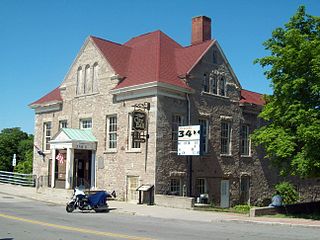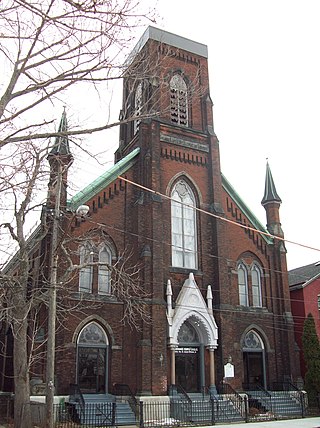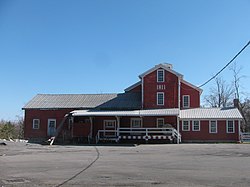
Amherst is a town in Erie County, New York, United States. It is a suburb of Buffalo. As of 2020, the town had a total population of 129,595. This represents an increase from 122,366 as reported in the 2010 census. It is the 14th most populated municipality in New York.

Williamsville is a village in Erie County, New York, United States. The population was 5,423 at the 2020 census. The village is named after Jonas Williams, an early settler. It is part of the Buffalo-Niagara Falls metropolitan area.
Amherst State Park is an 80-acre (0.32 km2) park in Erie County, New York, United States. The park is located northeast of Buffalo, partially in the Village of Williamsville with the balance located in the Town of Amherst. The park is managed by the Town of Amherst under an agreement with the New York State Office of Parks, Recreation and Historic Preservation.

Williamsville South High School is a high school located in Williamsville, New York, a suburb of Buffalo, New York. South is one of three high schools in the Williamsville Central School District, along with Williamsville North High School and Williamsville East High School.

This is a list of the National Register of Historic Places listings in Otter Tail County, Minnesota. It is intended to be a complete list of the properties and districts on the National Register of Historic Places in Otter Tail County, Minnesota, United States. The locations of National Register properties and districts for which the latitude and longitude coordinates are included below, may be seen in an online map.

Entranceway at Main Street at Roycroft Boulevard is a suburban residential subdivision entranceway built in 1918. It is on Main Street in the hamlet of Snyder, New York, in the town of Amherst within Erie County. The entranceway is a marker that represents the American suburbanization of rural areas, suburbanization that occurred through transportation-related land development on the edges of urban areas. It consists of a variety of half-height wall formations, featuring a semicircular wall on the Roycroft Boulevard median's intersection with Main Street. The entranceway was added to the National Register of Historic Places on December 7, 2005.

Benjamin C. Moore Mill is a historic flour mill, waterworks, and city hall building located at Lockport in Niagara County, New York. It is a stone structure built in 1859–60, as a flour mill for the Benjamin C. Moore Company. In 1864, Dwight Keep constructed this stone structure that was originally the Benjamin Moore Company Mill. Around 1884, it was converted from a flour mill, to one of the first water pumping plants in America. Within the basement of the Moore building, two of Birdsill Holly's pumps were installed, one pushing 3 million gallons of water and the other pushing 5 million, each utilizing the waterpower from the Mill Race. In 1893, the rear addition was constructed and the building was converted for use as city hall for the City of Lockport and was used as city hall until 1974, when the new city hall opened. It was listed on the National Register of Historic Places in 1973.

Chapel of Our Lady Help of Christians, also known as the Maria Hilf Chapel, is a historic Roman Catholic church located at Cheektowaga in Erie County, New York. It is part of the Diocese of Buffalo.

St. Andrew's Evangelical Lutheran Church Complex, also known as Deliverance Temple of God & Christ, is a historic Evangelical Lutheran church complex located at Buffalo in Erie County, New York. The complex consists of the original German Lutheran church structure constructed in 1859 and later remodeled into a school; the eclectic Gothic-Romanesque style church structure constructed in 1885; and the Queen Anne style parish house constructed in 1892.

The Williamsville Christian Church, also known as the Meeting House, is a historic Disciples of Christ church located at Williamsville in Erie County, New York. It is a 2+1⁄2-story brick Italianate-style structure constructed in 1871 and remodeled in about 1900.

The YMCA Central Building or Olympic Towers as the building is now known, is a historic YMCA building located at Buffalo in Erie County, New York. The tan-colored brick building with sandstone accents was designed by noted local architects Green & Wicks and constructed in 1901–1902. The building was home to the third oldest YMCA chapter in North America until converted to office use in the early 1980s.

St. Mary of the Angels Motherhouse Complex is a historic Roman Catholic convent located in the Town of Amherst in Erie County, New York. It was designed in 1928 by Dietel and Wade, who also designed Buffalo City Hall, as an expansion of the Amherst headquarters of the Sisters of St. Francis. It served the sisters until 1998, when the property was transferred to the State of New York and Town of Amherst for public park use. In 2004, the structure opened as a senior housing facility.
Duane Lyman (1886–1966) was an architect based in Buffalo, New York, known for his prolific career which included 100 school buildings, many churches, and numerous large homes both in the city and suburban communities. At the time of his death, Lyman was referred to as the "dean of Western New York Architecture."

Scoby Power Plant and Dam is a historic dam and now defunct power plant located between the towns of Ashford and Concord, near Springville, New York. The complex is located on the eastern bank of Cattaraugus Creek outside Springville. It is representative of a small hydroelectric generating facility of the early 20th century in Western New York. The complex was constructed in 1925, replacing a facility near this site.

Buffalo North Breakwater South End Light is a lighthouse formerly located at the entrance to Buffalo Harbor, Buffalo, New York, United States. It is one of two "bottle shaped" beacons located in Buffalo Harbor; the other is the South Buffalo North Side Light. It is a 29-foot (8.8 m) high beacon constructed of boiler plate. It measures 10 feet 3⁄4 inch (3.067 m) at the bottom and 2 feet 3 inches (0.69 m) at the top. It is distinguished by four cast iron port windows and a curved iron door. It was first lit on September 1, 1903, and originally equipped with a 6th-order Fresnel lens. A battery operated 12 volt lamp with a 12 inches (300 mm) green plastic lens was installed in the beacon c. 1960, when a domed roof formerly mounted over the lens was removed. The beacon was removed in 1985, and now stands on the grounds of the Buffalo (main) Light. Its twin is located at the Dunkirk Lighthouse and Veterans Park Museum.

There are 75 properties listed on the National Register of Historic Places in Albany, New York, United States. Six are additionally designated as National Historic Landmarks (NHLs), the most of any city in the state after New York City. Another 14 are historic districts, for which 20 of the listings are also contributing properties. Two properties, both buildings, that had been listed in the past but have since been demolished have been delisted; one building that is also no longer extant remains listed.

The New Hope Mills Complex is a historic grist mill complex located on Glen Haven Road near the intersection with Route 41A in the hamlet of New Hope in the town of Niles in Cayuga County, New York. The complex includes the mill building, two vernacular dwellings, a 1910s gambrel roofed storage barn, a 1935 saw mill, two concrete faced dams, and a 1-acre (4,000 m2) mill pond.

La Iglesia Pentecostal La Luz del Mundo / Light of the World Church Pentecostal Church is an Assemblies of God Pentecostal church in Williamsburg, Brooklyn, New York City, located at 179 South 9th Street, occupying the historic 19th-century former New England Congregational Church since 1955.

Minterburn Mill is a former textile mill complex located at 215 East Main Street, in the Rockville village of Vernon, Connecticut. Developed beginning in 1834, it was the first place in Rockville to be developed industrially, and the surviving buildings provide a view of evolutionary changes in mill architecture. The mill was listed on the National Register of Historic Places in 1984. It was converted into an apartment complex in 2016 by the state.

Rockwood Chocolate Factory Historic District is a historic industrial complex and national historic district in Fort Greene, Brooklyn, New York City. The complex consists of 16 contributing buildings built between 1891 and 1928 and owned by Rockwood & Company until it went out of business in 1957. The largest and oldest building dates to 1891 and is located at the corner of Washington and Park avenues. It is a five-story, Romanesque Revival style building. Much of the complex has been converted to loft apartments.






















